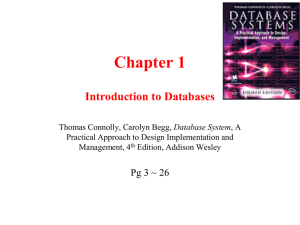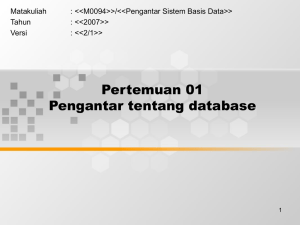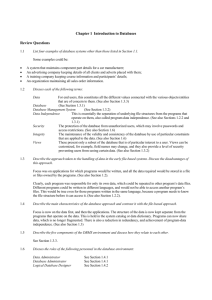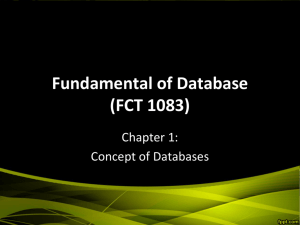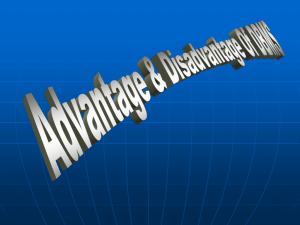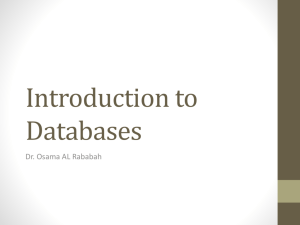Minggu 1, Pertemuan 1 Introduction to Database Matakuliah : T0206-Sistem Basisdata
advertisement
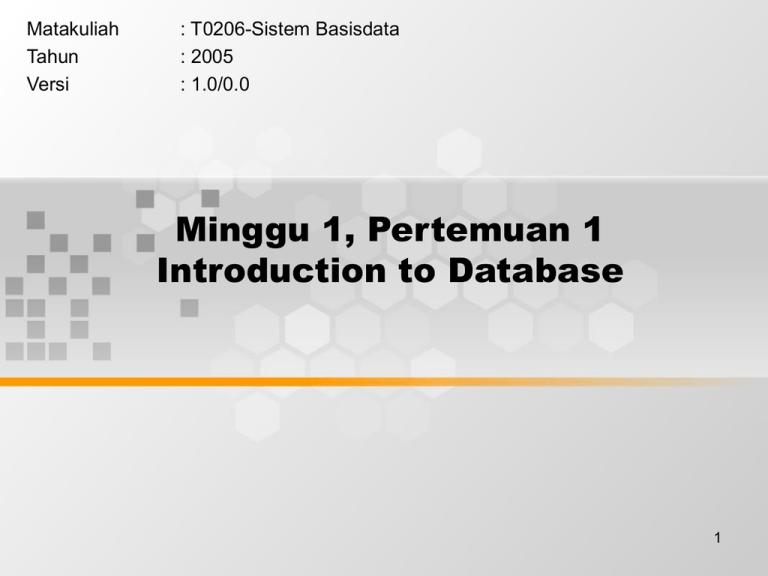
Matakuliah Tahun Versi : T0206-Sistem Basisdata : 2005 : 1.0/0.0 Minggu 1, Pertemuan 1 Introduction to Database 1 Learning Outcomes Pada akhir pertemuan ini, diharapkan mahasiswa akan dapat menerangkan konsep basisdata dan sistem basisdata serat keuntungan dan kerugiannya(C2) 2 Outline Materi • • • • • Some common uses of database systems. Characteristics of file-based systems. Problems with file-based approach. Meaning of the term database. Meaning of the term Database Management System (DBMS). 3 Outline Materi (lanjutan…) • Typical functions of a DBMS. • Major components of the DBMS environment. • Personnel involved in the DBMS environment. • History of the development of DBMSs. • Advantages and disadvantages of DBMSs. 4 Examples of Database Applications • • • • • • • Purchases from the supermarket Purchases using your credit card Booking a holiday at the travel agents Using the local library Taking out insurance Using the Internet Studying at university 5 File-Based Systems • Collection of application programs that perform services for the end users (e.g. reports). • Each program defines and manages its own data. 6 File-Based Processing 7 Limitations of File-Based Approach • Separation and isolation of data – Each program maintains its own set of data. – Users of one program may be unaware of potentially useful data held by other programs. • Duplication of data – Same data is held by different programs. – Wasted space and potentially different values and/or different formats for the same item. 8 Limitations of File-Based Approach • Data dependence – File structure is defined in the program code. • Incompatible file formats – Programs are written in different languages, and so cannot easily access each other’s files. • Fixed Queries/Proliferation of application programs – Programs are written to satisfy particular functions. – Any new requirement needs a new program. 9 Database Approach • Arose because: – Definition of data was embedded in application programs, rather than being stored separately and independently. – No control over access and manipulation of data beyond that imposed by application programs. • Result: – the database and Database Management System (DBMS). 10 Database • Shared collection of logically related data (and a description of this data), designed to meet the information needs of an organization. • System catalog (metadata) provides description of data to enable program– data independence. • Logically related data comprises entities, attributes, and relationships of an organization’s information. 11 Database Management System (DBMS) • A software system that enables users to define, create, and maintain the database and that provides controlled access to this database. 12 Database Management System (DBMS) 13 Database Approach • Data definition language (DDL). – Permits specification of data types, structures and any data constraints. – All specifications are stored in the database. • Data manipulation language (DML). – General enquiry facility (query language) of the data. 14 Database Approach • Controlled access to database may include: – – – – – A security system. An integrity system. A concurrency control system. A recovery control system. A user-accessible catalog. • A view mechanism. – Provides users with only the data they want or need to use. 15 Views • Allows each user to have his or her own view of the database. • A view is essentially some subset of the database. 16 Views • Benefits include: – Reduce complexity; – Provide a level of security; – Provide a mechanism to customize the appearance of the database; – Present a consistent, unchanging picture of the structure of the database, even if the underlying database is changed. 17 Components of DBMS Environment 18 Components of DBMS Environment • Hardware – Can range from a PC to a network of computers. • Software – DBMS, operating system, network software (if necessary) and also the application programs. • Data – Used by the organization and a description of this data called the schema. 19 Components of DBMS Environment • Procedures – Instructions and rules that should be applied to the design and use of the database and DBMS. • People 20 Roles in the Database Environment • Data Administrator (DA) • Database Administrator (DBA) • Database Designers (Logical and Physical) • Application Programmers • End Users (naive and sophisticated) 21 History of Database Systems • First-generation – Hierarchical and Network • Second generation – Relational • Third generation – Object Relational – Object-Oriented 22 Advantages of DBMSs • Control of data redundancy • Data consistency • More information from the same amount of data • Sharing of data • Improved data integrity • Improved security • Enforcement of standards • Economy of scale 23 Advantages of DBMSs • Balanced conflicting requirements • Improved data accessibility and responsiveness • Increased productivity • Improved maintenance through data independence • Increased concurrency • Improved backup and recovery services 24 Disadvantages of DBMSs • • • • • • • Complexity Size Cost of DBMS Additional hardware costs Cost of conversion Performance Higher impact of a failure 25
